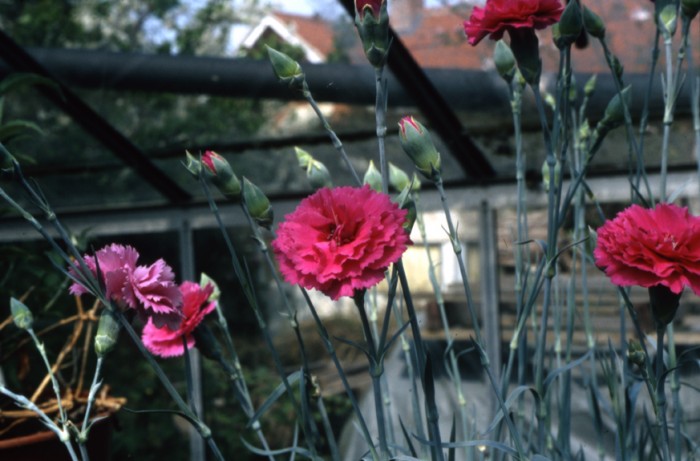For the economic gardener and for one who simply enjoys propagating and potting up there can be few plants better suited than the Dianthus family. These are all easy to multiply, and require this regularly as left to grow old they become straggly and dead in the middle.

Dianthus comprises Carnations, their humble but pretty relations the Pinks and those two
excellent garden hybrids; Sweet William and the lesser known Sweet Wivelsfield. Although the majority are usually grown outdoors in large containers, rockeries or sunny borders most of these plants, particularly Carnations, grow well in an unheated greenhouse. Some known as Perpetuals, and even more so the Malmaisons, really do require a greenhouse as they find most of the UK too cool and damp. Providing it’s well ventilated most Dianthus love the extra shelter though detesting it too hot, and without wind buffeting them their stems grow much taller giving excellent blooms for cutting. Thus you really need two batches, those for enjoying as the flowering plants and those intended for cutting for the house. Without doubt these do best in the greenhouse border with a big root run however more varieties can be squeezed in with, preferably larger not smaller, containers, ideally bucket size. Use a John Innes soil based potting compost, with extra grit and a tad extra chalk or calcified seaweed to be sure it’s slightly limey, they don’t like bad drainage or acid conditions. (I’ve long used chopped rotted down grass turves with crushed seashells and leaf mould but all these may be hard to get.)
Now there are a multitude of different varieties of all the various types of Dianthus. You could spend a lifetime exploring them, most have similar grey or green somewhat grassy foliage, white, pink, red and purple blooms, most with lovely scents, often sweet and clove like. Indeed they were once added to give this flavour to beer. Although many of the species can be grown from seed, layering is successful for almost all and cuttings, or pipings, are easy with most and especially handy with carnations. Growth needs to be strong then a stub of stem and leaves can be grasped firmly and pulled neatly from it’s socket further down. This can be done almost any time though if it’s flowering best remove the buds and blooms. Most of these slips will root, keep them slightly warm underneath but cool on top. Pot up once they root, only small pots to start getting bigger as they grow.
Although there are several pests and diseases most are never a problem as to be fair the plants are seldom long lived enough to worry about them. Unless methodical you tend to lose them and continuous replacement is called for which at least is easy. Indeed you do not even need get a plant, I have unnamed varieties with great sentimental value as these have been grown from slips culled from wedding and christening bouquets.


